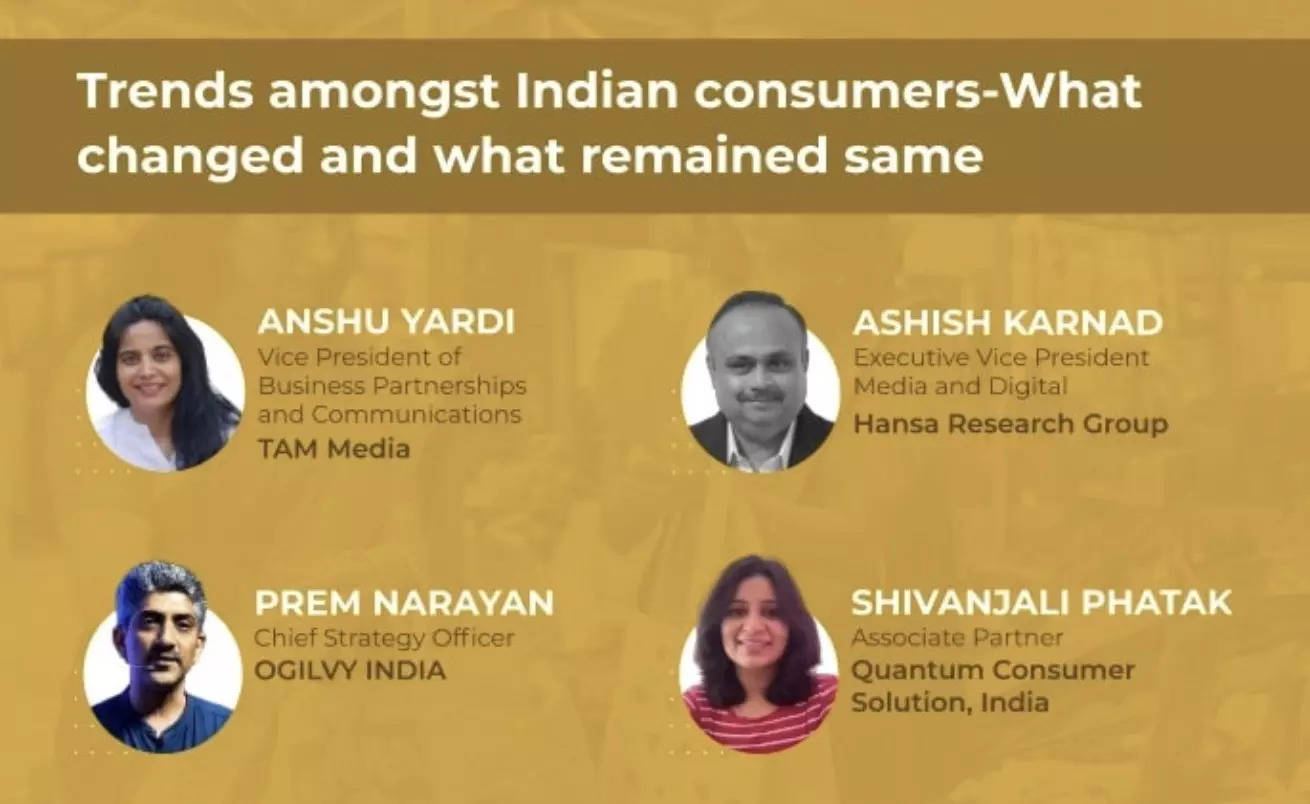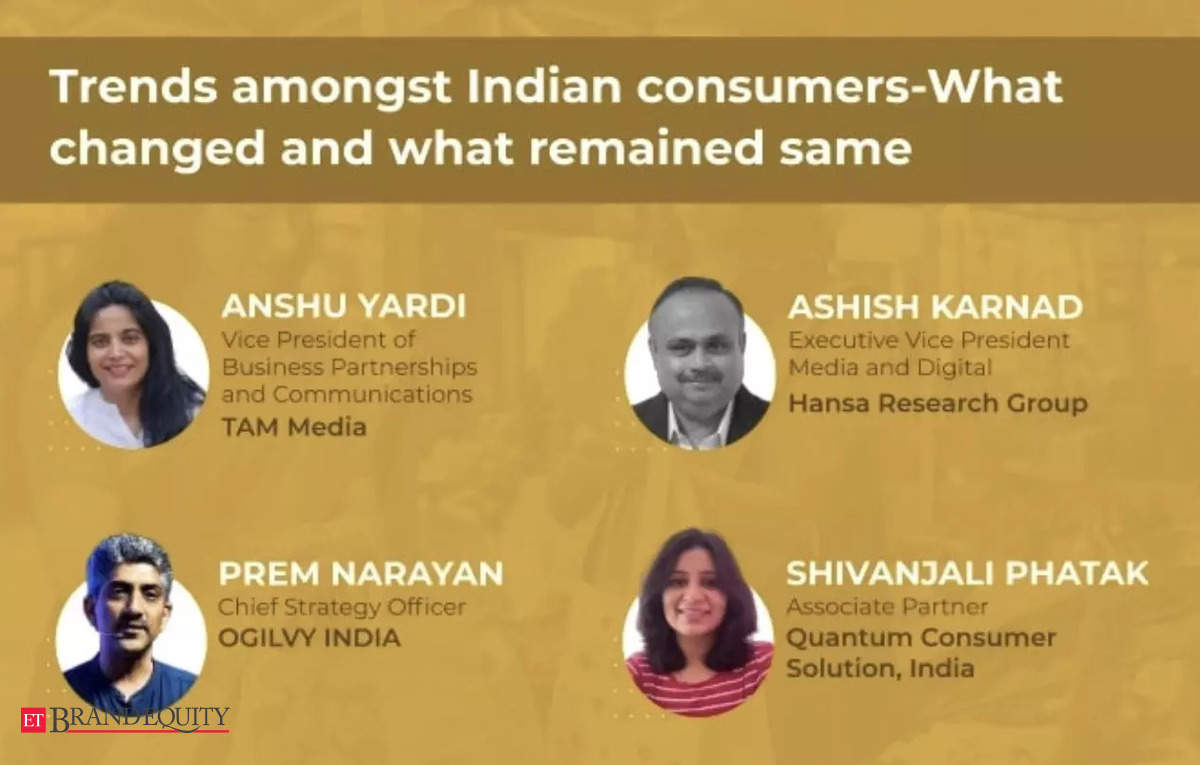[ad_1]

The MRSI or Market Research Society of India, hosted a webinar on trends amongst Indian consumers. Panelists brought to the picture their findings on trends from the year as it comes to an end. The panellists were Shivanjali Phatak, associate partner at Quantum Consumer Solution India; Prem Narayan, chief strategy officer at Ogilvy India; Anshu Yardi, vice president of business partnerships and communications at TAM Media and Ashish Karnad, executive vice president of media and digital at Hansa Research Group.
Phatak explained ‘How India is evolving’ through five sub-themes. Firstly, she talked about how Indians are beginning to understand their standing as members of a global superpower. There has been an uptick in the sense of pride and showcasing of their hyper-local identities.
Next, she explained how women are accepting their position as not just backend supporters of their households but as frontline enablers. As architects of their own lives, they aim to know and do more.
In terms of media and entertainment, people want to see more realism. Consumers want to watch things that can broaden their perspective of the real world. There is a newfound appreciation for authenticity and acceptance of things as imperfect. So, when it comes to entertainment media, the keyword is relatibility.
Phatak also spoke about how Covid-19 forced us to change the way we live and work for good. People are still looking to use less time and physical and mental effort to do mundane activities. Consumers also don’t want to go through the experience of being bombarded with choices. Aggregators that make it easy to make decisions, taking off that decision-making mental stress are appreciated.
India has also begun chasing quality of life. While we want to be successful, a large chunk of the population has realised that the relentless pursuit of success can cause damage. There is more time spent doing things that are practical and conscious. There has been an ‘eventification’ of family vacations and prioritisation of health and wellness. More Indians are indulging in me-time and slow and conscious living.
Narayan spoke about trends within beauty and how they have been changing. First, he articulates how beauty has gone from airbrushed to authentic. Social media has been at the forefront of this change, with both influencers and regular people cherishing imperfections. Audiences are not looking for dramatic transitions but an acceptance of normality and what would typically be considered flaws.
People have also begun trusting influencers who share their vulnerabilities rather than someone who portrays themselves as ‘perfect’ or a diva. Similarly, the overarching tone in beauty has shifted from a pursuit of looking good to loving the self. Guilt-free indulgence in well-being and prioritising mental and physical health over looks have taken centre stage this year.
As for products and brands, there is a rise in demand for products that are easy to use on the go. Beauty routines are not limited to big events or weddings; the get-ready-with-me (GRWM) trend that has taken the internet by storm focuses on getting ready for activities like going to the gym, shopping or a simple day out.
Within the beauty space, there has become a sisterhood where women want to help each other look better and feel better. There is no longer space for gatekeeping helpful information. Narayan also explained a concept called the ‘Fashionisation of beauty’, where beauty is following the path fashion originally did in terms of trends. From ‘clean girl’ to ‘soft girl’ or ‘barbie-core’, reels have become ramps for people to showcase their interpretation of a seasonal trend.
Beauty is also seeing a thirst for transparency and authenticity from brands. “Back of pack is now front of reels,” said Narayan. There was a time when people didn’t understand the chemical mumbo-jumbo on the ingredient list. But now, people have a well-formed understanding of ingredients like niacinamide and hyaluronic acid.
Creators are focussing on ingredient labels and even calling out over-priced brands that sell products with the same ingredients as other brands. This is a caution for marketers to be true to what they deliver, and build credibility in the product.
Finally, beauty-related content is not just consumed for educational or informational purposes. It is consumed as entertainment by both men and women. With pleasing aesthetics, humour and the main-character energy that content creators add to their videos, they have turned mobile screens into television, he added.
Yardi presented a report on television advertising trends, saying that there was a 27 per cent rise in ad volumes in 2021. In 2022, they stabilised, with a slight drop in 2023. Advertising in genres like general entertainment (GEC), movies and music have seen positive growth, while news and kids saw degrowth.
Auto, personal care and hygiene, BFSI and household products were the top growing sectors in 2023. She then shifted the focus to sports advertising, where the overall genre has shown an eight per cent growth in 2023. Over 140 brands were exclusive advertisers in sports. These categories include e-commerce, gaming, BFSI and pan masala.
Karnad spoke about the significance of celebrity endorsements and trends. TVCs have seen a growth in celebrity endorsements in Jan 2023 over Jan 2021. Of total TVCs, from 21 per cent being celebrity endorsed, it has increased to 28 per cent.
Celebrity endorsements also see a trend of longevity, with ten of the top 15 celebrities being common across four years. There is a particular appeal to celebrities who can fit many different categories.
As for consumers, the parameters they judge celebrities on are recognition, likability, following, how cluttered their partnerships are, perception, category fit and interest to see. He explained how while a celebrity like Ranveer Singh is high on valuation, as for consumer sentiment, he doesn’t score as much. This is attributable to the number of endorsements he does or his perception as a frisky person.
Karnad also points out ‘cord cutting’ or a decline in cable and satellite (C&S) connections in households. This is a trend that has been prevalent since COVID-19 due to their high cost and growth in OTT platforms. There is also a generation of people who have never subscribed to C&S. However; he points out that it is not a matter of concern for now as OTT platforms are not popular beyond metros and upmarket homes.
[ad_2]
Source link






